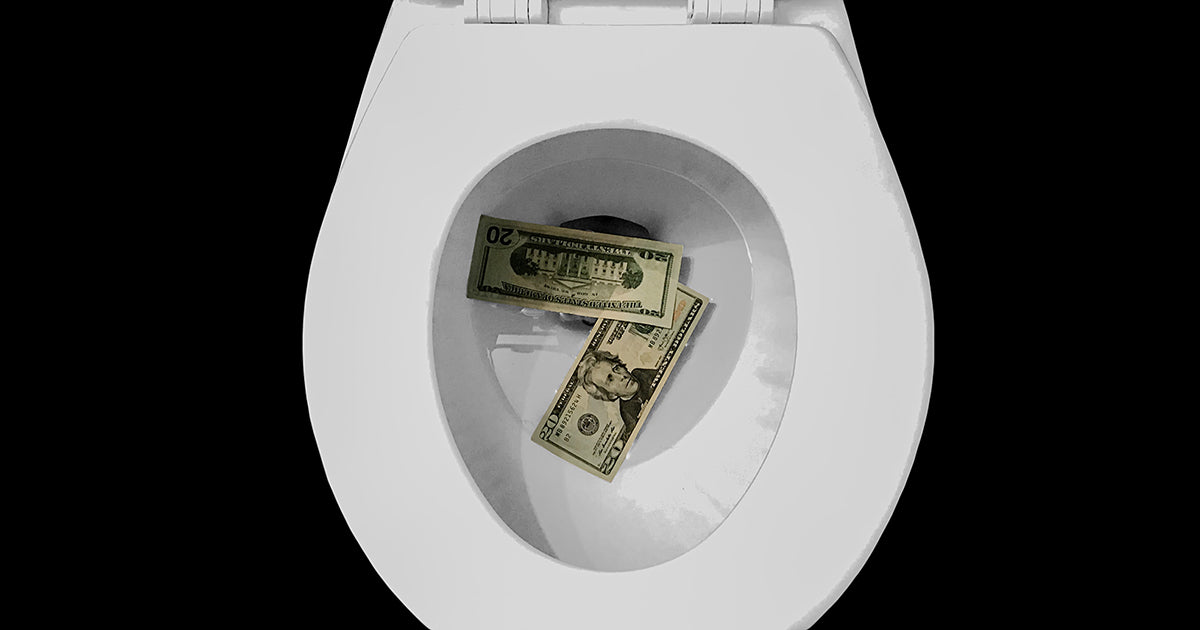Spending more than you need to can be incredibly frustrating, and we often don't realize just how much we could save simply by monitoring our money a little more closely. These are eight of the most common ways in which people unknowingly waste their money.
1. Streaming and Other Subscriptions
We switch between different monthly subscriptions pretty often, and it's easy to lose track of what you're paying for. This is especially true for subscriptions that automatically renew on your card and don't necessarily send any notifications for each monthly payment. There are also "free" trials that automatically convert to subscriptions at the end of the free period.
A recent study by the Waterstone Group found that more than 80 percent of Americans substantially underestimate how much they spend on subscriptions each month. They also noted a few of the subscriptions that we most commonly forget including dating apps, digital publications, and fitness apps. In total, Americans spend more than $2 billion per month on streaming services alone.
You can identify unnecessary subscriptions by simply checking your card statements at the end of each month for anything you don't need or aren't using. Subscription information for mobile applications is also available in the device's settings menu for easy access and cancellation.
2. Credit Card Interest
A credit card can be a great way to build up your credit and even earn rewards, but the reality is that they're usually much more profitable for the credit card company than for the cardholder. Credit cards are one of the top sources of debt for Americans, especially those under 35, and we will pay more than $120 billion in credit card interest in 2019 alone.
If you do choose to have a credit card, it's crucial to avoid carrying a balance whenever possible. Most cards come with interest rates between about 15 and 25 percent, and compound interest means you'll pay even more than your listed rate if you don't pay off your balance for a full year.
When you're struggling with credit card debt, it can feel overwhelming and impossible to get back on your feet. Start with small steps—don't charge anything new to any of your cards, and save as much as you can each month to pay off your debt. If you need to pay balances on multiple accounts, start with the card with the highest rate to avoid as much interest as possible.
In addition to credit card interest, you might also be losing money on other bank costs like ATM fees, overdraft fees, and minimum balance fees. Check your bank's website or mobile application for more information about your fees, and carefully track these costs to get an idea of what you're spending and how you could save money.
3. Underinflated Tires
You might not think of underinflated tires as a problem, but keeping your tires at the proper air pressure can save you a lot of money on gas. In fact, the US Department of Energy found that you can save an average of 0.6% by adding pressure to your underinflated tires.
0.6% doesn't sound like much, but it adds up to a lot over months and years of paying for gas. You lose roughly 0.2% on gas mileage for each drop of 1 psi in your tire pressure, so the average of 0.6% can rise as high as 3% depending on how underinflated your tires are, to begin with. If you drive 1,000 miles per month, pay $3 per gallon for gas, and get 25 miles to the gallon, inflating your tires could work out to up to $43.40 in savings per year.
You can find the optimal tire pressure in your owner's manual for your vehicle, and tire pressure gauges and air compressors are available at most auto shops. These small upfront costs could save you hundreds of dollars over a lifetime of driving if you remember to check your tire pressure regularly.
4. Fabric Softener and Dryer Sheets
While many of us assume that fabric softeners, dryer sheets, and other laundry accessories are necessary for keeping your clothes in top condition, they aren't actually that beneficial and can in some cases cause more problems than they solve.
A 2011 University of Washington study found a connection between scented laundry products like dryer sheets and fabric softeners and higher levels of several hazardous chemicals, two of which are carcinogenic. Removing these from your laundry routine could improve the air quality in your home and prevent these chemicals from reaching public water sources.
You'll spend a lot less on laundry each year without paying for fabric softeners or dryer sheets, and you'll notice little to no difference in the texture or appearance of your clothing. In fact, using fabric softener can actually make your clothes more irritating and flammable.
If you really miss the effects of either scented product, you can easily make a replacement using common household items. A small amount of baking soda in each load will have a similar effect, and a few balls of aluminum foil perform the same function as dryer sheets.
You can save even more on your energy bill by switching from an electric dryer to line-drying clothes after washing. Hanging up laundry works just as well as a dryer, and dryers alone are responsible for four percent of the average American household electricity consumption. We spend more than $100 annually on electric dryers, an entirely unnecessary cost that can be easily replaced by line-drying.
5. Plastic Water Bottles
Plastic water bottles are another common household item that has a negative effect on the environment, and they're just as easy to replace as dryer sheets or fabric softener. The average American goes through roughly 13 water bottles per month, which works out to more than 150 every year.
At $1 each, you could be spending $150 or more per year on water bottles alone. Reusable bottles cost a fraction of that price and are much more convenient than having to buy a water bottle whenever you're out of the house.
Water bottles and other single-use plastics are incredibly harmful to the environment, and 32% of these materials end up in Earth's oceans. By moving to a reusable water bottle, you're doing your part to reduce our impact on the environment at a critical time in our planet's history.
6. Coffee
If you're a coffee drinker, you can also save money by purchasing a reusable coffee mug rather than using disposable cups. In addition to the environmental benefits, you'll also be able to save money at some coffee shops—Starbucks, for example, offers a ten-cent discount if you bring your own cup.
Of course, going out for coffee is a major expense on its own, and it's easy to underestimate how much you're spending when it's just four or five dollars at a time. Amerisleep polled more than 1,000 Americans who drink coffee and found that people from 25-34 spend over $2,000 on coffee per year, while the 35-44 demographic was close behind at just above $1,400.
Making high-quality coffee at home requires more investment upfront, but that initial cost will be more than offset by years of saving what you would have spent at cafés. You can usually buy a 12-ounce bag of beans for around $10 to $20 depending on quality and location, and that should be more than enough for a week of coffee. $10 per week works out to just ~$520 per year, much less than most coffee drinkers between 25 and 44 are currently spending.
7. Missed 401(k) Employer Matches
Most large American businesses offer employee 401(k) plans, and around half of those companies match contributions—effectively doubling a portion of your salary up to the maximum match allowed according to your company's policy. In 2015, Financial Engines discovered that only three-fourths of all employees contributed enough to receive the full match.
Among the one-quarter who left at least some money on the table, the average loss was $1,336, or more than $42,000 over 20 years. Missed matches accounted for an average of 2.4% missed income and a total of $24 billion each year.
If you don't think you're receiving your entire match amount, check your employee handbook for more information or speak to someone in HR. They should be able to help you set up a higher contribution each month and ensure that you put in at least enough to get the full match.
8. Premium Warranties
You can get an extended or premium warranty on computers, cars, appliances, and more, and they're sold as a way to protect yourself from the risk of damage. Yet many of these warranties only cover damage from specific causes and aren't as helpful as they sound—remember that sellers will only offer warranties if they think they lead to a positive return on investment.
The FTC points out that you may save more by putting money into a savings account rather than spending it on an extended warranty. You might end up paying a higher sum for repairs on one or two products, but you'll still come out ahead compared to how much you would have spent on the warranties. Americans spent roughly $38 billion on warranties in 2013 alone.
With these eight tips, you should be able to identify unnecessary expenses and take steps to save money each month. Remember to monitor your bank statements carefully to see if you have any more room to cut costs—a few minor adjustments can add up to significant savings over time.
Written by Logan Allec for Your Money Geek and legally licensed through the Matcha publisher network. Please direct all licensing questions to legal@getmatcha.com.





Leave a comment
All comments are moderated before being published.
This site is protected by hCaptcha and the hCaptcha Privacy Policy and Terms of Service apply.